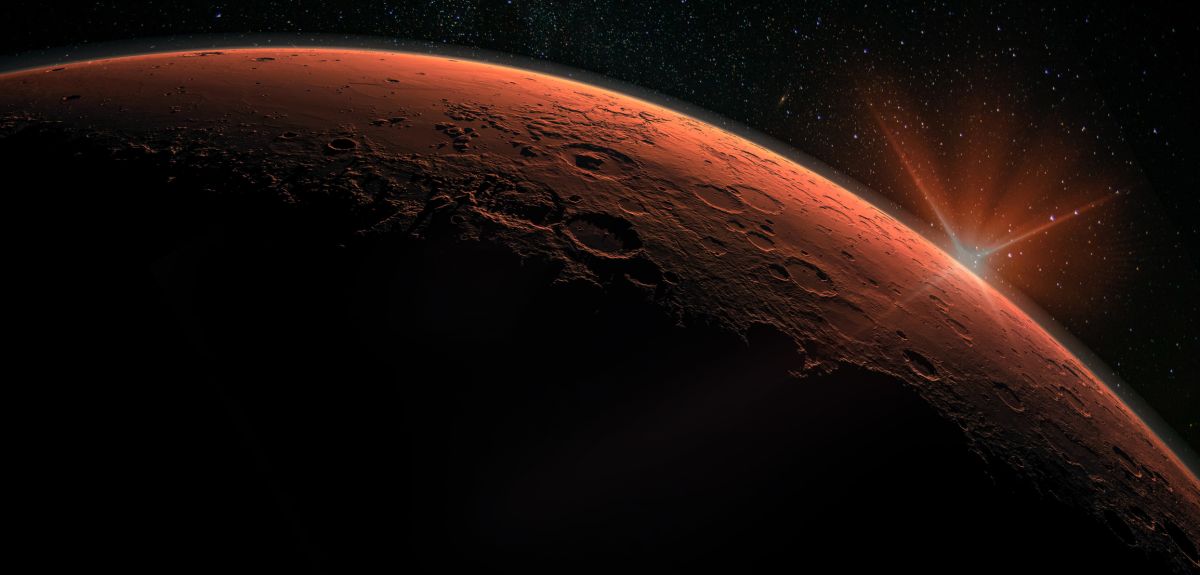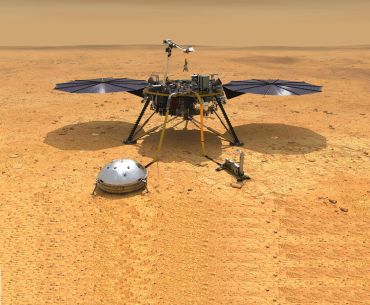
New study reveals source of largest ever Mars quake
A global team of scientists led by the University of Oxford have announced the results of an unprecedented collaboration to search for the source of the largest ever seismic event recorded on Mars. The study rules out a meteorite impact, suggesting instead that the quake was the result of enormous tectonic forces within Mars’ crust. The results have been published today in the journal Geophysical Research Letters.
 An illustration of NASA's InSight spacecraft with its instruments deployed on the Martian surface. Credits: NASA/JPL-Caltech.
An illustration of NASA's InSight spacecraft with its instruments deployed on the Martian surface. Credits: NASA/JPL-Caltech.Although Mars is smaller than Earth, it has a similar land surface area because it has no oceans. In order to survey this huge amount of ground – 144 million km2 – study lead Dr Benjamin Fernando from the University of Oxford’s Department of Physics sought contributions from the European Space Agency, the Chinese National Space Agency, the Indian Space Research Organisation, and the United Arab Emirates Space Agency. This is thought to be the first time that all missions in orbit around Mars have collaborated on a single project.
During its time on Mars, InSight (which was co-designed by the University of Oxford) recorded at least 8 marsquake events caused by meteoroid impacts. The largest two of these formed craters around 150m in diameter. If the S1222a event was formed by an impact, the crater would be expected to be at least 300m in diameter. Each group examined data from their satellites orbiting Mars to look for a new crater, or any other tell-tale signature of an impact (e.g. a dust cloud appearing in the hours after the quake).
After several months of searching, the team announced today that no fresh crater was found. They conclude that the event was instead caused by the release of enormous tectonic forces within Mars’ interior. This indicates that the planet is much more seismically active than previously thought.
This project represents a huge international effort to help solve the mystery of S1222a, and I am incredibly grateful to all the missions who contributed. I hope this project serves as a template for productive international collaborations in deep space.
Dr Benjamin Fernando, Department of Physics, University of Oxford.
Dr Fernando said: ‘We still think that Mars doesn’t have any active plate tectonics today, so this event was likely caused by the release of stress within Mars’ crust. These stresses are the result of billions of years of evolution; including the cooling and shrinking of different parts of the planet at different rates. We still do not fully understand why some parts of the planet seem to have higher stresses than others, but results like these help us to investigate further. One day, this information may help us to understand where it would be safe for humans to live on Mars and where you might want to avoid!’
Dr Daniela Tirsch, Science Coordinator for the High Resolution Stereo Camera on board the European Space Agency’s Mars Express Spacecraft said: ‘This experiment shows how important it is to maintain a diverse set of instruments at Mars, and we are very glad to have played our part in completing the multi-instrumental and international approach of this study.’
From China, Dr Jianjun Liu (National Astronomical Observatories, Chinese Academy of Sciences) added: ‘We are willing to collaborate with scientists around the world to share and apply this scientific data to get more knowledge about Mars, and are proud to have provided data from the colour imagers on Tianwen-1 to contribute to this effort.’
Dr Dimitra Atri, Group Leader for Mars at New York University Abu Dhabi and contributor of data from the UAE’s Hope Spacecraft, said: ‘This has been a great opportunity for me to collaborate with the InSight team, as well as with individuals from other major missions dedicated to the study of Mars. This really is the golden age of Mars exploration!’
S1222a was one of the last events recorded by InSight before its end of mission was declared in December 2022. The team are now moving forward by applying knowledge from this study to future work, including upcoming missions to the Moon and Titan’s Moon Saturn.
The study ‘A tectonic origin for the largest marsquake observed by InSight’ has been published in Geophysical Research Letters.
 Expert Comment: Chatbot-driven sexual abuse? The Grok case is just the tip of the iceberg
Expert Comment: Chatbot-driven sexual abuse? The Grok case is just the tip of the iceberg
 New study finds that stopping weight-loss drugs is linked to faster regain than ending diet programmes
New study finds that stopping weight-loss drugs is linked to faster regain than ending diet programmes